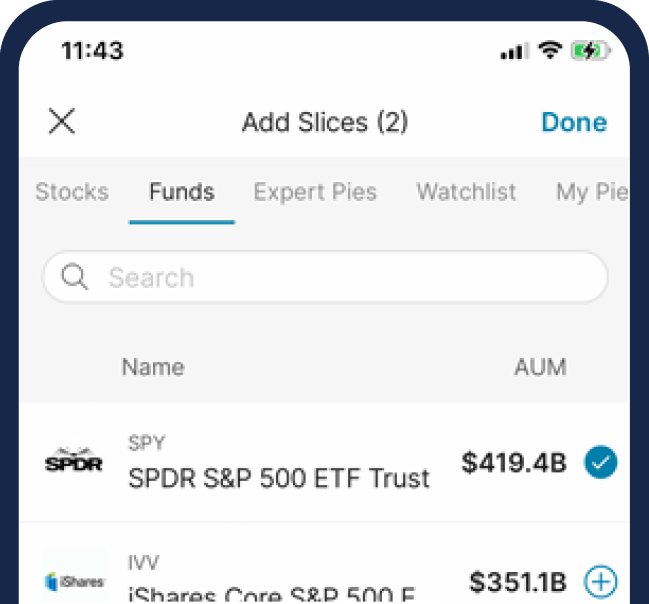Lump-sum investing vs. Dollar-cost averaging

Two of the most common investing strategies are lump-sum investing and dollar-cost averaging. Lump-sum investing is when an investor invests a significant amount of money all at once, while dollar-cost averaging is when an investor invests a fixed amount of money at regular intervals over time.
In this post, we’ll give examples of both, discuss the advantages and disadvantages, how to use them on M1, and what to consider when choosing a strategy.
What is lump-sum investing?
Lump-sum investing is a strategy in which an investor invests a significant amount of money all at once.
An investor may receive a tax refund, inheritance, or just have some savings that they want to invest immediately. Rather than spacing their investments out, they plan to invest it at one time, in one asset or in a diversified portfolio.
On M1, you can invest a lump sum of money in stocks, ETFs, and other securities as part of a Pie you design yourself. Find out more.
Lump-sum investing example
Let’s say you have $12,000 in your savings that you chose to invest. With lump-sum investing, you would invest all $12,000 into your portfolio all at once. While this exposes your entire investment to the market’s volatility, investing a lump-sum can lead to immediate profit or loss.
With automated investing features, you can implement these strategies into your financial plan on M1.

Advantages and disadvantages of lump sum investing
Advantages
- Immediate Exposure to the Market and Potential for Faster Returns: if you expect the markets to rapidly appreciate in a short to medium term, putting all your capital to work might yield you the quickest returns in the shortest amount of time by locking in lower cost basis for your investments.
- This is also a disadvantage because it means higher or faster losses too.
Disadvantages
- Market Timing and Potential Loss: Markets are volatile and predicting the next bull run (rapid appreciation) is incredibly challenging. If the market experience prolonged downturn after you invest all your funds, you could be stuck with losses for a long time and wouldn’t be able to improve your cost basis by investing in the downturn to improve your cost basis.
- Emotion: Market volatility right after a large investment can lead to emotional reactions that may lead to impulsive decisions.
M1 does not provide investment advice, and this is not an offer or solicitation of an offer, or advice to buy or sell any security, and you are encouraged to consult your personal investment, legal, and tax advisors. Past performance does not guarantee future performance.
What is dollar-cost averaging (DCA)?
Dollar-cost averaging is a strategy in which an investor spreads out their investments equally over time. This fixed approach buys more shares when prices are low and less shares when prices are high. It is typically a long-term strategy.
Dollar-cost averaging example
Let’s say you have $12,000 in your savings that you chose to invest. With dollar-cost averaging, you could invest $500 every two weeks for a year or any other regular intervals that you choose. Regardless of market conditions or factors impacting your portfolios, you stick to your investment schedule. At the end of the year, all $12,000 will have been invested at various prices over time.
A 401(k) plan is a common example of dollar-cost averaging. Each payday, a portion of an employee’s earnings are invested in the plan.
Advantages and disadvantages of dollar-cost averaging
Advantages
- Planning: By using DCA you create your own plan and stick to it regardless of the market volatility. This allows you to take emotions out of investing and focus on the long term goal.
- Investing Through Downturns: DCA allows you to lower your cost basis by continuing to invest through market downturns. Being n the market through highs and lows lowers your overall exposure to volatility and reduces your risk.
- Affordability: DCA may be a more affordable option for some people. While $12k may not be available for some investors at one time, $500 every two weeks could be a more realistic option. By spreading out investments, you can potentially grow your wealth on a longer but more affordable timeframe.
Disadvantages
- Opportunity cost: There is a potential for opportunity cost if the security experiences a significant increase and you are not fully invested.
- Schedule Considerations: If your DCA schedule is too long such as investing 12k over next 5 years, you may have to consider inflation as it can erode your buying power.
M1 does not provide investment advice, and this is not an offer or solicitation of an offer, or advice to buy or sell any security, and you are encouraged to consult your personal investment, legal, and tax advisors. Past performance does not guarantee future performance.
Using M1’s automation for dollar-cost averaging
You can set-up recurring transfers to fund your M1 account weekly, biweekly, or monthly. You can choose any dollar amount then, with Auto-Invest, M1 will automatically invest your cash balance into your portfolio spreading the sum across your target allocations.
Choosing a strategy
Your strategy ultimately depends on your financial plan, risk tolerance, and investing goals. You can find other strategies here: Types of investing strategies: Which are right for you?
Consider lump-sum investing if:
- You have a significant amount of money to invest
- You believe your timing is favorable or that the investment will grow in the long-term
Consider dollar-cost averaging if:
- You would prefer smaller amounts of money, invested over time
- You want to potentially reduce market volatility
- You want an “set and forget” investing strategy
The M1 line
Lump-sum investing and dollar-cost averaging are two of many strategies to consider in your financial plan. Lump-sum money enters the market all at once, which offers the potential for earlier returns but also the risk of immediate exposure to risk.
Dollar-cost averaging provides a steady strategy of investing at predefined intervals and dollar amounts, which can reduce market impact but also cause you to potentially miss out on growth. As always, do your research for what strategy best fits you and your investing needs.
20230913-3100610-9872059
